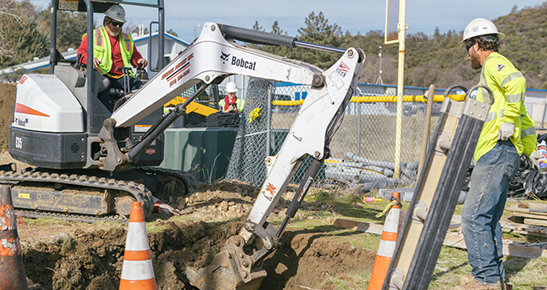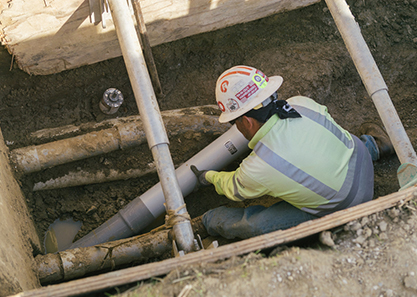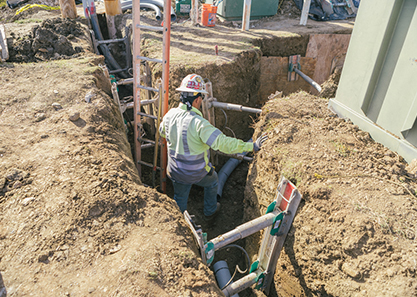CPUC Rule 20 Programs:
Overhead-to-Underground
Conversion of Electric Power Lines

Overview
To help improve community aesthetics and meet our commitment to provide clean, safe and reliable energy to our customers, we continuously make upgrades to our electric infrastructure. This includes working in partnership with local governments to underground our overhead electric power lines through the Rule 20 programs, as authorized by the California Public Utilities Commission (CPUC). Currently, more than 15,254 miles of SDG&E’s electric distribution lines, or about 63% of the regional distribution system, is underground.
Some of the benefits of overhead-to-underground conversion include:
- Beautification of local neighborhoods and commercial districts
- Increased grid resiliency, as undergrounded power lines can remain energized during Public Safety Power Shutoffs, which are enacted as a measure of last resort to prevent wildfires during extreme fire weather conditions
- Reduced likelihood of power outages caused by vehicles accidents that damage power poles
Because undergrounding projects are costly and tend to benefit those in the immediate vicinity the most, the CPUC limits the funding of conversions by the general ratepayer under its Rule 20 program.

SDG&E construction crew install electrical conduit in a trench, intersecting a substructure, for underground electric facilities.
What is Rule 20
In 1967, the California Public Utilities Commission (CPUC) established Electric Tariff Rule 20, which defines policies and procedures for California’s investor-owned electric utilities (IOUs), including SDG&E, to convert overhead power lines and other equipment to underground facilities. Cities identify overhead lines that they wish to convert to underground and, in consultation with their investor-owned utility, determine if the conversion project qualifies. Aesthetic enhancement has been the primary focus of the program.
The Rule 20 program is currently divided into three subprograms that provide diminishing levels of ratepayer contributions to projects – Rule 20A, 20B, and 20C.
What is Rule 20A
Rule 20A is a subprogram of Rule 20 that allocates ratepayer-funded work credits to California’s communities to fund utility underground conversion projects. Rule 20A projects are nominated by cities or counties and are paid for by customers through their electric utility bill. The City of San Diego has a separate undergrounding program in partnership with SDG&E that is not funded by Rule 20A.

SDG&E construction crew excavate trench for electrical conduit and substructures.

Crew is preparing to remove shoring and backfill trench for new underground electrical lines.
What is Rule 20B
Conversion projects under Rule 20B are funded partially by general ratepayers and partially by those requesting the underground conversion (property owners, municipalities, counties, developers, etc.) served by the overhead facilities to be removed. The Rule 20B Program provides limited ratepayer funding for underground conversions that do not qualify under Rule 20A or in cases where the city or county does not have sufficient Rule 20A funding for the project. Developer driven Rule 20B projects do not receive funding from ratepayers.
What is Rule 20C
The Rule 20C Program allows property owners to pay for undergrounding projects that do not qualify under Rule 20A or Rule 20B. Conversion projects under Rule 20C are typically funded by those requesting the underground conversion (property owners, municipalities, counties, developers, etc.). 20C projects receive a ratepayer-funded credit for salvage and depreciation.

SDG&E crew installs conduit in new underground trench.
Recent Changes to Rule 20
On June 3, 2021, and June 8, 2023, the CPUC issued respective Phase 1 and Phase 2 decisions that significantly revised the rules for the Rule 20 program.
The Phase 1 Decision on “Revising Electric Rule 20 and Enhancing Program Oversight” revised Electric Rule 20 as follows: (a) discontinues new work credit allocations for Electric Rule 20A projects after Dec. 31, 2022, (b) clarifies Electric Rule 20A project eligibility criteria and work credit transfer rules, and (c) enhances program oversight.
Per the Commission’s direction, SDG&E has notified each community of its existing work credit balance.
The Phase 2 Decision on “Revising Electric Rule 20 and Establishing Local and Tribal Government Consultation Requirements” revised Electric Rule 20 as follows:
(a) An Active Rule 20A Project shall be defined as a project with a signed resolution that the utility has designated as either “active” or on “hold.”
(b) A Rule 20A project that a utility has designated as “on hold” is a project that was initiated but stopped for an indeterminate amount of time due to the community possessing insufficient work credits to fund the entire project.
(c) Any Rule 20A work credit that has not been allocated to a community with an Active Rule 20A Project within two years of the effective date of this decision (June 8, 2023) shall be deemed expired.
(d) Communities shall have the option to contribute financially to any Rule 20A project that has insufficient work credits for completion.
(e) Any Rule 20A work credit that has not been deducted from a community’s work credit balance by December 31, 2033, shall be deemed expired.
(f) The utility shall prioritize reallocation of work credits (pursuant to Section 2C of Rule 20A) from inactive communities to Active Rule 20A Projects with insufficient work credits. The reallocation of such work credits is made first to either:
- (1) Active Rule 20A Projects located in a city, unincorporated county or tribal jurisdiction that has not completed a Rule 20A project since 2004.
- (2) Active Rule 20A Projects where at least 50 percent of the main line trench distance will be located within Environmental and Social Justice Community census tract(s).
- (3) Per the Phase 2 decision, the Rule 20D concluded on June 8, 2023.
For more information on Rule 20, please refer to the Electric Rule 20 Guidebook.